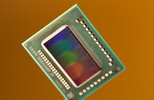Intel Core i7-3610QM vs Intel Core i7-3630QM
Intel Core i7-3610QM
► remove from comparison
Der Intel Core i7-3610QM ist ein schneller mobiler Quad-Core Prozessor basierend auf der Ivy Bridge Architektur. Dank Hyperthreading können die 4 Kerne gleichzeitig bis zu 8 Threads bearbeiten. Die Fertigung erfolgt im Gegensatz zum Vorgänger Sandy Bridge, der noch in 32 Nanometer produziert wurde, in einem kleineren 22 Nanometer Prozess mit 3D-Transistoren. Mit einer Taktrate von 2,3 GHz (maximaler Turbo: 3,1 GHz für 4 Kerne, 3,2 GHz für 2 Kerne, 3,3 GHz für 1 Kern) befindet sich der i7-3610QM deutlich unter dem i7-3720QM (2,6 GHz) und besitzt einen 6 MB großen L3-Cache. Vom i7-3615QM unterscheidet er sich durch einen geringeren GPU-Takt.
Ivy Bridge ist ein Die Shrink der Sandy Bridge Architektur, der nur an wenigen Stellen verbessert wurde. Unter anderem werden nun PCI Express in der neuen Version 3.0 sowie DDR3(L)-1600 unterstützt. Keine Änderungen gab es beim Featureset, welches weiterhin beispielsweise die Verschlüsselungstechnik AES-NI, die Befehlssatzerweiterung AVX sowie Turbo-Boost 2.0 umfasst. Die größten Änderungen gab es bei der integrierten Prozessorgrafikkarte und den Multimedia Features. Bis auf VT-d und vPro unterstützt der 3610QM alle Funktionen des Ivy Bridge Kerns wie VT-x, Trusted Execution und AES Funktionen.
Die Performance des i7-3610QM liegt durch kleinere Verbesserungen der Pro-MHz-Leistung etwa 5 % über einem taktgleichen Modell der Sandy Bridge Architektur. Verglichen mit dem i7-3720QM fällt der Prozessor etwa 10 % zurück und erreicht den i7-2920XM der Vorgängergeneration. Dies genügt, um selbst anspruchsvolle Anwendungen wie HD-Videoschnitt oder aktuelle 3D-Spiele mit Leichtigkeit zu meistern.
Für die Grafikausgabe zeigt sich die im Prozessor integrierte Intel HD Graphics 4000 mit 16 sogenannten Execution Units (EUs) verantwortlich. Mittels Turbo-Modus kann die Ausgangstaktrate von 650 MHz bis auf 1100 MHz ansteigen. Die Leistung liegt um etwa 40 % über der des Vorgängers (HD Graphics 3000), womit auch knapp die Grafiklösung von Llano (Radeon HD 6620G als schnellstes Modell) erreicht bzw. teils übertroffen wird.
Wie die meisten Quadcore-Modelle der Sandy Bridge Reihe besitzt auch der i7-3610QM eine TDP von 45 Watt, die auch die Grafikeinheit beinhaltet. Damit ist die CPU lediglich für große Notebooks ab 15 Zoll aufwärts geeignet.
Intel Core i7-3630QM
► remove from comparison
Der Intel Core i7-3630QM ist ein schneller mobiler Quad-Core Prozessor basierend auf der Ivy Bridge Architektur und Nachfolger des i7-3610QM. Dank Hyperthreading können die 4 Kerne gleichzeitig bis zu 8 Threads bearbeiten. Die Fertigung erfolgt im Gegensatz zum Vorgänger Sandy Bridge, der noch in 32 Nanometer produziert wurde, in einem kleineren 22 Nanometer Prozess mit 3D-Transistoren. Mit einer Taktrate von 2,4 GHz (maximaler Turbo: 3,2 GHz für 4 Kerne, 3,3 GHz für 2 Kerne, 3,4 GHz für 1 Kern) befindet sich der i7-3630QM unter dem i7-3720QM (2,6 GHz) und besitzt einen 6 MB großen L3-Cache.
Ivy Bridge ist ein Die Shrink der Sandy Bridge Architektur, der nur an wenigen Stellen verbessert wurde. Unter anderem werden nun PCI Express in der neuen Version 3.0 sowie DDR3(L)-1600 unterstützt. Keine Änderungen gab es beim Featureset, welches weiterhin beispielsweise die Verschlüsselungstechnik AES-NI, die Befehlssatzerweiterung AVX sowie Turbo-Boost 2.0 umfasst. Die größten Änderungen gab es bei der integrierten Prozessorgrafikkarte und den Multimedia Features. Bis auf VT-d und vPro unterstützt der 3630QM alle Funktionen des Ivy Bridge Kerns wie VT-x, Trusted Execution und AES Funktionen.
Die Performance des i7-3630QM liegt durch kleinere Verbesserungen der Pro-MHz-Leistung etwa 5 % über einem taktgleichen Modell der Sandy Bridge Architektur. Verglichen mit dem i7-3720QM fällt der Prozessor etwa 5 bis 10 % zurück und übertrifft den i7-2920XM der Vorgängergeneration. Dies genügt, um selbst anspruchsvolle Anwendungen wie HD-Videoschnitt oder aktuelle 3D-Spiele mit Leichtigkeit zu meistern.
Für die Grafikausgabe zeigt sich die im Prozessor integrierte Intel HD Graphics 4000 mit 16 sogenannten Execution Units (EUs) verantwortlich, die mit 650 - 1150 MHz takten. Die Leistung liegt um etwa 40 % über der des Vorgängers (HD Graphics 3000), womit auch knapp die Grafiklösung von Llano (Radeon HD 6620G als schnellstes Modell) erreicht bzw. teils übertroffen wird.
Wie die meisten Quadcore-Modelle der Sandy Bridge Reihe besitzt auch der i7-3630QM eine TDP von 45 Watt, die auch die Grafikeinheit beinhaltet. Damit ist die CPU lediglich für große Notebooks ab 15 Zoll aufwärts geeignet.
| Model | Intel Core i7-3610QM | Intel Core i7-3630QM | ||||||||||||||||||||||||||||||||||||||||||||||||||||||||||||||||||||||||||||||||||||||||||||||||||||||||||||||||||||||||||||||||||||||||||||||||||||||||
| Codename | Ivy Bridge | Ivy Bridge | ||||||||||||||||||||||||||||||||||||||||||||||||||||||||||||||||||||||||||||||||||||||||||||||||||||||||||||||||||||||||||||||||||||||||||||||||||||||||
| Series | Intel Core i7 | Intel Core i7 | ||||||||||||||||||||||||||||||||||||||||||||||||||||||||||||||||||||||||||||||||||||||||||||||||||||||||||||||||||||||||||||||||||||||||||||||||||||||||
| Serie: Core i7 Ivy Bridge |
|
| ||||||||||||||||||||||||||||||||||||||||||||||||||||||||||||||||||||||||||||||||||||||||||||||||||||||||||||||||||||||||||||||||||||||||||||||||||||||||
| Clock | 2300 - 3300 MHz | 2400 - 3400 MHz | ||||||||||||||||||||||||||||||||||||||||||||||||||||||||||||||||||||||||||||||||||||||||||||||||||||||||||||||||||||||||||||||||||||||||||||||||||||||||
| L1 Cache | 256 KB | 256 KB | ||||||||||||||||||||||||||||||||||||||||||||||||||||||||||||||||||||||||||||||||||||||||||||||||||||||||||||||||||||||||||||||||||||||||||||||||||||||||
| L2 Cache | 1 MB | 1 MB | ||||||||||||||||||||||||||||||||||||||||||||||||||||||||||||||||||||||||||||||||||||||||||||||||||||||||||||||||||||||||||||||||||||||||||||||||||||||||
| L3 Cache | 6 MB | 6 MB | ||||||||||||||||||||||||||||||||||||||||||||||||||||||||||||||||||||||||||||||||||||||||||||||||||||||||||||||||||||||||||||||||||||||||||||||||||||||||
| Cores / Threads | 4 / 8 | 4 / 8 | ||||||||||||||||||||||||||||||||||||||||||||||||||||||||||||||||||||||||||||||||||||||||||||||||||||||||||||||||||||||||||||||||||||||||||||||||||||||||
| TDP | 45 Watt | 45 Watt | ||||||||||||||||||||||||||||||||||||||||||||||||||||||||||||||||||||||||||||||||||||||||||||||||||||||||||||||||||||||||||||||||||||||||||||||||||||||||
| Transistors | 1400 Million | 1400 Million | ||||||||||||||||||||||||||||||||||||||||||||||||||||||||||||||||||||||||||||||||||||||||||||||||||||||||||||||||||||||||||||||||||||||||||||||||||||||||
| Technology | 22 nm | 22 nm | ||||||||||||||||||||||||||||||||||||||||||||||||||||||||||||||||||||||||||||||||||||||||||||||||||||||||||||||||||||||||||||||||||||||||||||||||||||||||
| Die Size | 160 mm2 | 160 mm2 | ||||||||||||||||||||||||||||||||||||||||||||||||||||||||||||||||||||||||||||||||||||||||||||||||||||||||||||||||||||||||||||||||||||||||||||||||||||||||
| max. Temp. | 105 °C | 105 °C | ||||||||||||||||||||||||||||||||||||||||||||||||||||||||||||||||||||||||||||||||||||||||||||||||||||||||||||||||||||||||||||||||||||||||||||||||||||||||
| Socket | FCPGA988 | FCPGA988 | ||||||||||||||||||||||||||||||||||||||||||||||||||||||||||||||||||||||||||||||||||||||||||||||||||||||||||||||||||||||||||||||||||||||||||||||||||||||||
| Features | HD Graphics 4000 (650-1100MHz), DDR3(L)-1600 Memory Controller, HyperThreading, AVX, Quick Sync, Virtualization | HD Graphics 4000, DDR3(L)-1600 Memory Controller, HyperThreading, AVX, Quick Sync, Virtualization | ||||||||||||||||||||||||||||||||||||||||||||||||||||||||||||||||||||||||||||||||||||||||||||||||||||||||||||||||||||||||||||||||||||||||||||||||||||||||
| iGPU | Intel HD Graphics 4000 (650 - 1100 MHz) | Intel HD Graphics 4000 (650 - 1150 MHz) | ||||||||||||||||||||||||||||||||||||||||||||||||||||||||||||||||||||||||||||||||||||||||||||||||||||||||||||||||||||||||||||||||||||||||||||||||||||||||
| Architecture | x86 | x86 | ||||||||||||||||||||||||||||||||||||||||||||||||||||||||||||||||||||||||||||||||||||||||||||||||||||||||||||||||||||||||||||||||||||||||||||||||||||||||
| $378 U.S. | ||||||||||||||||||||||||||||||||||||||||||||||||||||||||||||||||||||||||||||||||||||||||||||||||||||||||||||||||||||||||||||||||||||||||||||||||||||||||||
| Announced | = 4700 days old | = 4540 days old | ||||||||||||||||||||||||||||||||||||||||||||||||||||||||||||||||||||||||||||||||||||||||||||||||||||||||||||||||||||||||||||||||||||||||||||||||||||||||
| Manufacturer | ark.intel.com |
Benchmarks
Average Benchmarks Intel Core i7-3610QM → 100% n=31
Average Benchmarks Intel Core i7-3630QM → 103% n=31
* Smaller numbers mean a higher performance
1 This benchmark is not used for the average calculation













